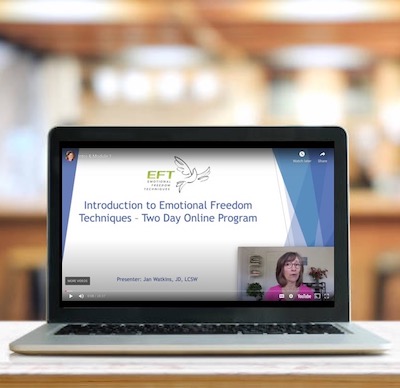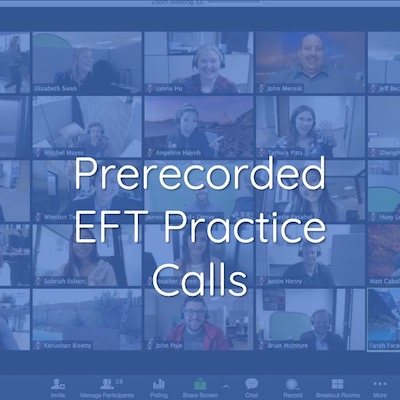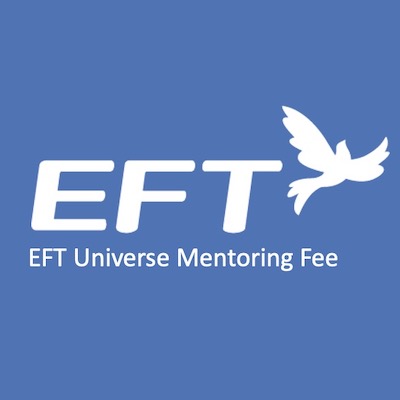Description
Prerecorded Online Training (no live audience)
Take-when-you-want / Unlimited Access
Includes actual recorded EFT sessions for enhanced learning
The course includes a thorough introduction to Emotional Freedom Techniques (“EFT/Tapping”), along with opportunities to tap-a-long and practice the technique. Actual recorded EFT sessions are included as extra modules. Intermediate and Advanced students will be able to review techniques, identify how to integrate tapping with other modalities and increase skills and confidence. What’s included:
- 22 modules (each is approximately 30 to 45 minutes)
- Tap-along practice opportunities
- Recorded EFT sessions for your enhanced learning
- Facebook group: you can ask questions here and the instructor will answer them weekly
- Additional Charge: Monthly Zoom practice call packages with review and practice – open to all of Jan’s EFT workshop and online trainees. Sign up for a “Live Online EFT Practitioner Calls” here.
Sign up for this introductory course from experienced EFT Trainer and Mentor who has worked with hundreds of people in thousands of sessions!
Course Preview
Module 3 explains what EFT is and how to use it.
Course Objectives
At the conclusion of the program, participants will be able to:
- Explain how stress impacts mental health and how EFT reduces stress.
- Explain how to use tapping on acupressure points while thinking of a problem as a way to rapidly reduce the emotional impact of memories and incidents that trigger emotional distress.
- Summarize current EFT research.
- Describe how to integrate EFT with your current therapy approach.
- Demonstrate EFT core and advanced techniques.
- Explain how dealing with client emotional reactions can be used for quick shifts.
- Explain how to overcome common barriers to success using EFT.
- Explain how to discuss EFT with your client.
- Explain how EFT can be used for anxiety, depression, PTSD, and phobias.
- Discuss uses of EFT for anxiety related cravings.
- Explore how EFT can be an additional tool for symptoms of other diagnoses such as ADD, ADHD, substance issues, and physical issues.
- Explain how EFT can be used to transform relationships.
- Identify the characteristics of a traumatizing event.
- Identify powerful EFT questions for effective EFT sessions.
- Identify powerful uses of Positive EFT.
- Present case studies to illustrate EFT results.
- Provide demonstrations and opportunities for experiencing EFT.
Intended Audience
- Mental health professionals working with clients individually and in groups
- Health professionals working with clients dealing with physical and mental health issues, including individuals and groups in hospital settings, recovery groups, pre and post-surgery groups
- Coaches working with clients
- Parents, school personnel and teachers
- Anyone interested in mastering the art of processing emotions quickly and clearing old unresolved issues
Modules
Module 1 & 2: What is EFT? Where did it come from?
- History and development of EFT
- Acupuncture, Acupressure, Kinesiology, Thought Field Therapy
- Impact of stress on the body – parasympathetic and sympathetic nervous systems
- EFT as a stress reduction method
Module 3 & 4: Basic Formulas, What to use it for
- EFT Techniques
- EFTs full Basic Recipe
- EFT Shortcut Recipe
- 9 Gamut technique
Module 5: EFT and Stress
Module 6: Blocks and Resistance
- Psychological reversal
- Secondary benefit
Module 7 & 8: Getting Good Results
- Treatment Strategies – Keys for effective use of EFT
- Setting meaningful, reachable goals
- Identifying and dealing with subconscious limiting beliefs
- Dealing with difficult childhood events and early programming
- Understanding cognitive shifts and generalization
- Importance of specificity, aspects, staying negative and testing
Module 9: Core Beliefs, Tabletops, Generalizations
- Finding the root of dysfunctional beliefs
Module 10: Adding EFT to your Practice
- Transform your practice with EFT
- EFT as a client-centered therapy
- Case conceptualization
- Integrating EFT with your current modalities, including EMDR
- Introducing EFT to your clients
- Using progressively more focused techniques
- Humor in your practice
- Tapping for personal and professional issues
- Empowering your client to process negative emotions, negative thoughts and physical sensations
- When the client is the expert
- Simple, empowering homework to enhance results
- EFT as a self-help tool!
Module 11: How EFT Works
- Theories for why EFT works
- Memory Reconsolidation
- Adaptive Memory Processing
- The limbic system and the amygdala
- Polyvagal theory
Module 12 & 13: EFT and Trauma & Research
- What to do when traumatic memories surface
- Characteristics of traumatizing events
- The Flight, Flight, Freeze response
- How trauma is reinforced in the brain
- Clearing the trauma capsule
- Handling excessive intensity in sessions
- Gentle techniques
- Useful dissociation
- Research
- Current research and limitations
- EFT Risks and other considerations
Module 14-15: EFT and Anxiety & EFT and Depression
- EFT for different Anxiety, Depression, PTSD diagnoses
- Anxiety, Depression, PTSD
- Other diagnoses
- Using EFT to evolve any situation
- Emotional components of mental disorders
- Discussion – EFT in crisis situations
Module 16: EFT and Physical symptoms
- Physical sensations and pain
- Supporting physical recovery by using EFT for emotional contributors to physical pain
- The importance of somatic elements to clear unresolved emotions
- Techniques to facilitate the processing of somatic elements
Module 17: Cravings
Module 18: Movie Technique
Module 19: Positive EFT
- When and how to use “Positive EFT”
- EFT Choices Statement created by Pat Carrington
- Opening and closing a session
- When time is limited
Module 20: Choices Statement
Module 21: Children
Module 22: In Closing
Cancellation / Refund Policy
If you are not satisfied with the product, please email me at janlwatkins.com. Fees may be applied to other online or live workshops given by trainer.




